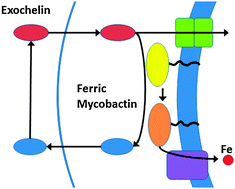Characterization of Fe(iii) sequestration by an analog of the cytotoxic siderophore brasilibactin A: Implications for the iron transport mechanism in mycobacteria†
Abstract
Mycobacteria such as M. tuberculosis represent a significant health concern throughout much of the developing world. In mycobacteria and other pathogenic bacteria, an important


 Please wait while we load your content...
Please wait while we load your content...